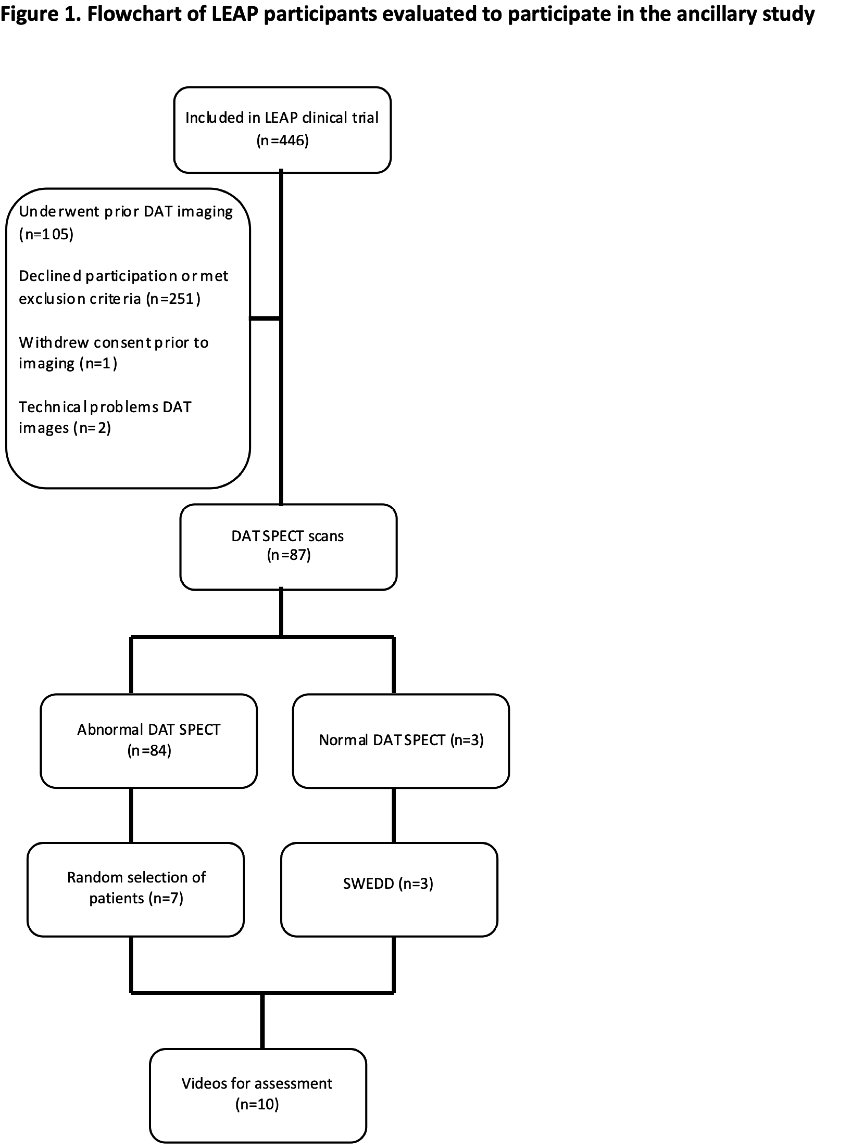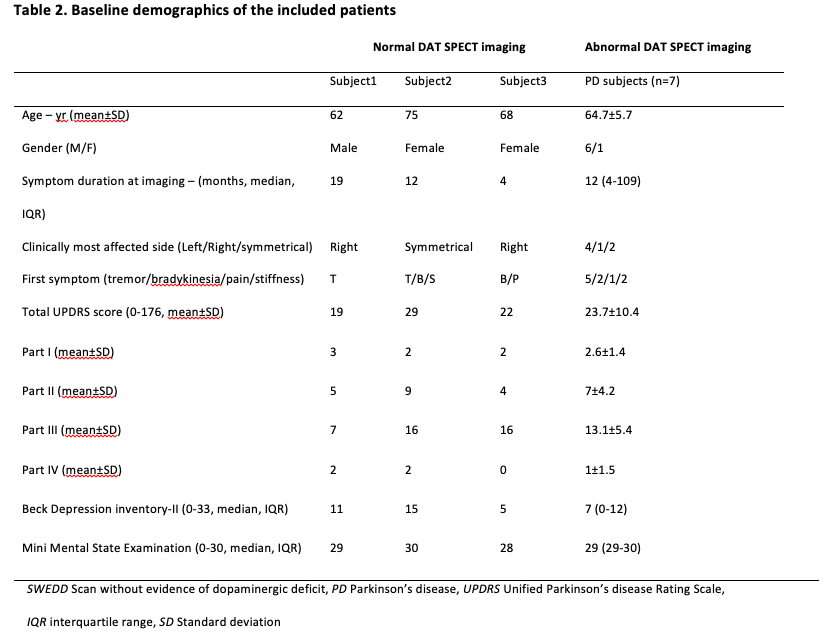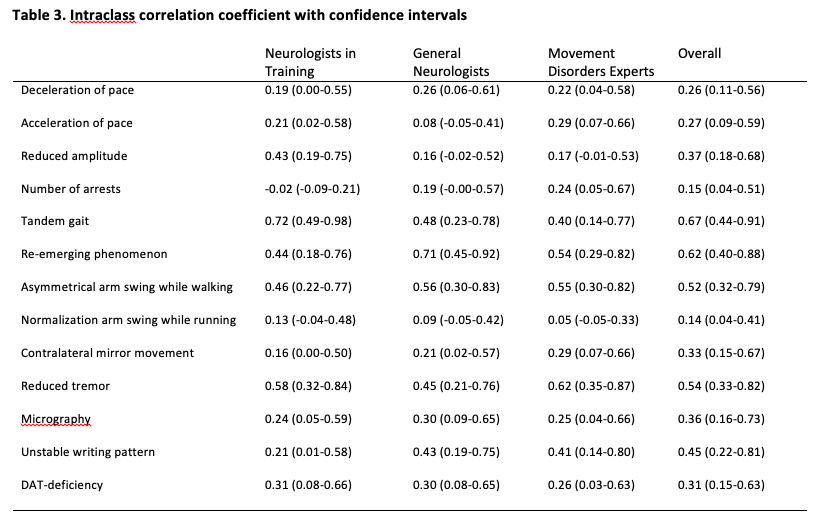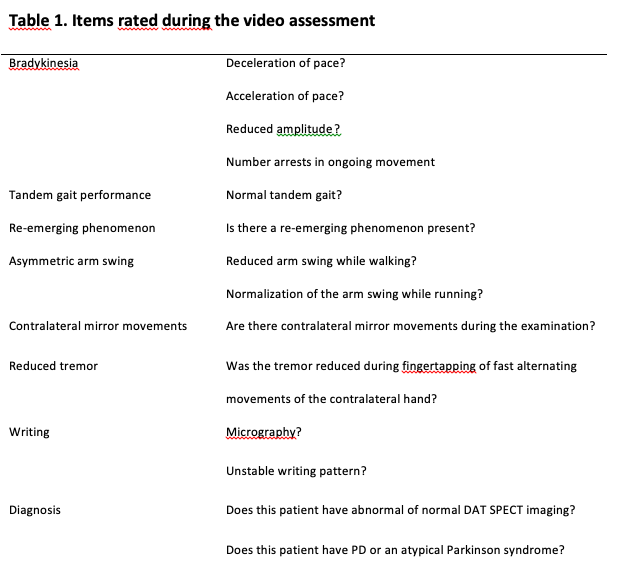Session Information
Date: Wednesday, September 25, 2019
Session Title: Phenomenology and Clinical Assessment of Movement Disorders
Session Time: 1:15pm-2:45pm
Location: Les Muses Terrace, Level 3
Objective: To investigate the usefulness of clinical features to differentiate subjects with “scans without evidence of dopaminergic deficit” (SWEDD) from patients presumed to have Parkinson’s disease (PD).
Background: To date, PD remains primarily a clinical diagnosis. An accurate diagnosis may be challenging, especially in early stages.1,2 Misdiagnosis occurs in 5-25% of the patients.3 Among patients enrolled in clinical trials or imaging studies for PD that undergo dopamine transporter single photon emission computed tomography imaging (DAT SPECT), 1-15% have SWEDD.4,5
Method: This study was an ancillary study to the LEAP trial; a randomized delayed-start trial.6,7 Patients were eligible for the LEAP trial if they had received a diagnosis of PD within the past two years and if they had insufficient disability to warrant treatment with antiparkinson medication. Patients were excluded from the ancillary study if they had a DAT SPECT prior to recruitment in the LEAP or if they used medication interfering with DAT binding. After inclusion, DAT SPECT imaging was performed and a comprehensive neurological examination, focused on parkinsonism (Table 1), was recorded on video. A panel of 6 neurologists in training (NT), 6 general neurologists (GN), and 6 movement disorders experts (MDE) analyzed the videos for the presence or absence of specific signs, while blinded for the imaging results. The raters were also asked if they suspected the subject to have a normal or abnormal DAT SPECT imaging. All raters received the same ten videos consisting of all SWEDD subjects and a random sample of PD patients. The panel did not now the ration of SWEDD/PD patients in the videos.
Results: Ten participants were included in this ancillary study (Figure 1). The baseline characteristics are shown in table 2. SWEDD subjects were correctly identified in 41.2% of the cases. NT correctly identified 50.0% (median, range 0-70%), GN 33.3% (0-66.7%), and MDE 66.7% (0-100%) of the SWEDD subjects. The overall intraclass correlation coefficient (ICC) of the individual items is poor to moderately with ICCs ranging from 0.14 till 0.67 (Table 3).
Conclusion: The panel consisting of NT, GN, and MDE could not reliably identify SWEDD subjects among patients with PD based solely on video assessment. Inter-rater agreement is poor to moderately regardless of the level of expertise.
References: 1. Litvan I, Agid Y, Calne D, Campbell G, Dubois B, Duvoisin RC, et al. Clinical research criteria for the diagnosis of progressive supranuclear palsy (Steele-Richardson-Olszewski syndrome): report of the NINDS-SPSP international workshop. Neurology. 1996;47(1):1-9. 2. Rajput AH, Rozdilsky B, Rajput A. Accuracy of clinical diagnosis in parkinsonism–a prospective study. Can J Neurol Sci. 1991;18(3):275-8. 3. Newman EJ, Breen K, Patterson J, Hadley DM, Grosset KA, Grosset DG. Accuracy of Parkinson’s disease diagnosis in 610 general practice patients in the West of Scotland. Mov Disord. 2009;24(16):2379-85. 4. Bajaj NP, Gontu V, Birchall J, Patterson J, Grosset DG, Lees AJ. Accuracy of clinical diagnosis in tremulous parkinsonian patients: a blinded video study. J Neurol Neurosurg Psychiatry. 2010;81(11):1223-8. 5. Marek K, Seibyl J, Eberly S, Oakes D, Shoulson I, Lang AE, et al. Longitudinal follow-up of SWEDD subjects in the PRECEPT Study. Neurology. 2014;82(20):1791-7. 6. Verschuur CVM, Suwijn SR, Boel JA, Post B, Bloem BR, van Hilten JJ, et al. Randomized Delayed-Start Trial of Levodopa in Parkinson’s Disease. N Engl J Med. 2019;380(4):315-24. 7. Verschuur CV, Suwijn SR, Post B, Dijkgraaf M, Bloem BR, van Hilten JJ, et al. Protocol of a randomised delayed-start double-blind placebo-controlled multi-centre trial for Levodopa in EArly Parkinson’s disease: the LEAP-study. BMC Neurol. 2015;15:236.
To cite this abstract in AMA style:
S. Suwijn, R. de Bie. An explorative study on the value of clinical features for diagnosing Parkinson’s disease [abstract]. Mov Disord. 2019; 34 (suppl 2). https://www.mdsabstracts.org/abstract/an-explorative-study-on-the-value-of-clinical-features-for-diagnosing-parkinsons-disease/. Accessed December 25, 2025.« Back to 2019 International Congress
MDS Abstracts - https://www.mdsabstracts.org/abstract/an-explorative-study-on-the-value-of-clinical-features-for-diagnosing-parkinsons-disease/




